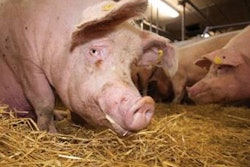Few other external influences have the potential to hit the income of the pork producer as negatively as a swine virus known by the initials PRRS. This pathogen can have serious consequences for the pig’s reproduction as well as for its respiration. In fact, it is regarded as probably the number one enemy to pig health globally in terms of its economic cost.
It is little wonder, therefore, that the veterinary scientists try everything possible to stop this virus either reaching the pigs or doing them severe harm. One result has been the installation of some pig buildings that include sophisticated filters for the incoming air. The idea is to strip microbes out of the air before they can enter and infect the animals.
At the experimental level, there is an idea to supplement this filtration by also using the germicidal properties of ultra-violet light to keep the air clean inside the house. It is too early to say if this will prove to be effective in practice, but I hope the researchers involved do not forget to check the animal feed.
They could be affecting feed quality without realizing it. As many technicians will know, there is an easy way to speed up the oxidation of fats in feeds and so promote rancidity. That is by exposing the feeds to ultra-violet light.














